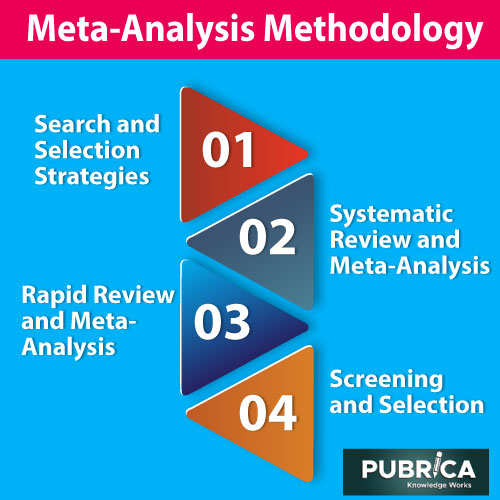
The importance of case report writing in evidence-based practice
February 24, 2021
Current developments in bioinformatics and computational biology: A Systematic Review
March 5, 2021In-Brief
- Conventional meta analysis research techniques are extended to accommodate methods and practices found in basic research.
- Apart from clinical research, where consolidation efforts are facilitated by systematic review and meta analysis research, basic science occasionally use such rigorous quantitative methods.
- Pubrica blog explains, meta-analyses offer informed estimates for biological consequences and the range of their variability, which are essential for the hypothesis generation and evidence-driven design of translational studies, as well as the development of computational models
Introduction
Evidence-based practise aims to combine the best evidence with clinical and patient expertise. Systematic reviews and meta-analyses are necessary tools for combining evidence needed for clinical decision making and policy. Systematic reviews help combine available literature using specific search parameters followed by logical synthesis of multiple primary studies and critical appraisal. Meta-analysis denotes the statistical analysis of the data from other independent fundamental studies that focus on the same question. The objective is to create an estimation about the studied phenomenon, for example, the intervention’s effectiveness. In clinical research, systematic reviews and meta-analyses act as an essential part of evidence-based medicine.
However, in fundamental science, efforts taken to evaluate literature review in such a quantitative and rigorous form are rare, and narrative reviews are prevalent. The manuscript aims to offer a brief computational resource, theoretical foundation and workflow outline for accomplishing a systematic or rapid review monitored by a meta-analysis of primary research studies. Meta-analyses can be a difficult undertaking, requiring tedious screening and statistical understanding. There are various guides found which outline how to undertake a meta-analysis in clinical research.
Meta-Analysis Methodology
1. Search and Selection Strategies
The first stage of any review contains formulating a primary objective in the form of a research question or hypothesis. Reviewers must clearly define the review’s aim before starting preceding the project, which helps decrease the risk of data dredging, where commentators later assign meaning to essential findings. Precaution must be taken since the search strategies are formulated for the primary objectives to define the secondary objective, which may not completely encompass the body of the work needed to address the secondary objective. Based on the purpose of a review, reviewers select a rapid or systematic review. The meta-analytic methodology is similar to systematic and rapid reviews; the scope of literature assessed tends to be significantly narrower for rapid reviews allowing the project to progress faster.

2. Systematic Review and Meta-Analysis
Systematic reviews include a comprehensive search strategy that allows the reviewers to recognize all related studies in a particular topic. Systematic reviews have the potential to produce information-rich databases which permit extensive secondary analysis. Examine the pool of existing information. Search standards must be sensitive enough not to miss relevant studies. Important terms and concepts conveyed as index terms and synonymous keywords, such as Medical Subject Headings, must be collected using Boolean operators AND, OR and NOT. Wildcards, Truncation and proximity operatives can help improve the search strategy by providing different wording for the same concept and spelling variation. Searching approaches can be validated using a selection of expected relevant studies. If some strategy fails to retrieve one among the selected studies, the research strategy needs further optimization. Updating the search strategy in every iterative step continues until the search strategy performs at a satisfactory level. A comprehensive prediction to return a vast number of studies is not relevant to the topic, usually resulting in a specificity of <10%. Hence, the starting stage, i.e. examining through the library to choose related studies, is time-consuming and is open to human error. Nevertheless, systematic reviews can provide the highest-quality quantitative evidence synthesis to directly inform the experimental and computational basic, preclinical and translational studies.
3. Rapid Review and Meta-Analysis
The objective of the rapid review, as mentioned in the name, it helps in reducing the time needed to synthesize the data. Rapid reviews are an appropriate alternative to systematic approaches if reviewers prefer to get a general idea of the field’s state without a prolonged time investment. Search policies are constructed by increasing search specificity, decreasing the number of inappropriate studies discovered by searching comprehensiveness cost. A rapid review’s strength is its flexibility to adapt to the reviewer’s needs, resulting in a lack of standardized methodology.
Common shortcuts made in rapid reviews are:
- Narrow down the search criteria,
- Striking date restrictions,
- Conducting the review with a single reviewer,
- Neglecting expert consultation (i.e., librarian for search strategy development),
- Constricting language criteria (ex. English only),
- Preceding the iterative process of searching and search period selection,
- Neglecting quality checklist criteria and
- Limiting the number of databases searched.
These shortcuts will restrict the initial pool of studies returned from the search, thus advancing the selection process, potentially result in the segregation of relevant studies and the introduction of selection bias. Rapid reviews do not reflect detriment quality or synthesize misrepresentative results.
While there is consent that rapid reviews do not sacrifice quality or synthesize misrepresentative results, it is suggested that critical outcomes be later confirmed by systematic review. Nevertheless, rapid reviews are a feasible alternative when parameters for computational modelling need to be valued. While systematic and rapid reviews rely on various strategies to select the related studies, the statistical methods used to produce data from the systematic and rapid review are identical.
4. Screening and Selection
When the literature search is wide-ranging, articles are taken out and stored in a place manager for screening. Before research screening, the addition and elimination criteria must be defined to ensure constancy in study identification and recovery, especially when multiple reviewers are involved. The serious steps in screening and selection are
- Eliminating duplicates
- Screening for related studies by title and abstract, and
- Inspecting full texts to make sure they fulfil the suitability criteria.
Some reference managers accessible, including Mendeley and Rayyan, exactly developed to help with screening systematic reviews.
However, 98% of journalists report using Endnote, Reference Manager or RefWorks to prepare their reviews. Reference managers often have duplication functions; however, these can be tedious and error-prone. A protocol for faster and more reliable duplication in Endnote has been recently proposed. The articles’ selection should be suitably broad, not subject to a single lab or author. In primary research articles, it is collective to find data sets reused by the same group in multiple studies. Therefore, additional securities should be taken when determining to contain multiple studies published by a single group. Screening and selection procedure, the reviewer acquires a complete list of good full-text manuscripts. The full screening and selection procedure should be stated in a PRISMA diagram, which maps the data flow throughout the review according to arranged guidelines published elsewhere.
Conclusion
Meta-analytic methods permit reviewers to quantitatively evaluate and synthesize results across studies to obtain data on statistical significance and relevance—systematic reviews of fundamental research data which have the potential of producing information-rich databases which allow extensive secondary analysis.
Our meta-analyses experts provide a meta-analysis writing service that will ensure a thorough review of your research question, conduct a systematic review, data extraction, and standardization and weighting studies and finally select and apply an appropriate model to compare effect sizes across different studies.
References
- Efthimiou, O. (2018). Practical guide to the meta-analysis of rare events. Evidence-based mental health, 21(2), 72-76.
- Paterson, B. L., Thorne, S. E., Canam, C., & Jillings, C. (2001). Meta-study of qualitative health research: A practical guide to meta-analysis and meta-synthesis (Vol. 3). Sage.
